LINK TO HOME PAGE/CONTENTS: HOME PAGE – CONTENTS
PART 2 – CEDARBURG – A GERMAN AMERICAN FARM TOWN AT THE TURN OF THE CENTURY
contents ©2016 by Harold Pfohl
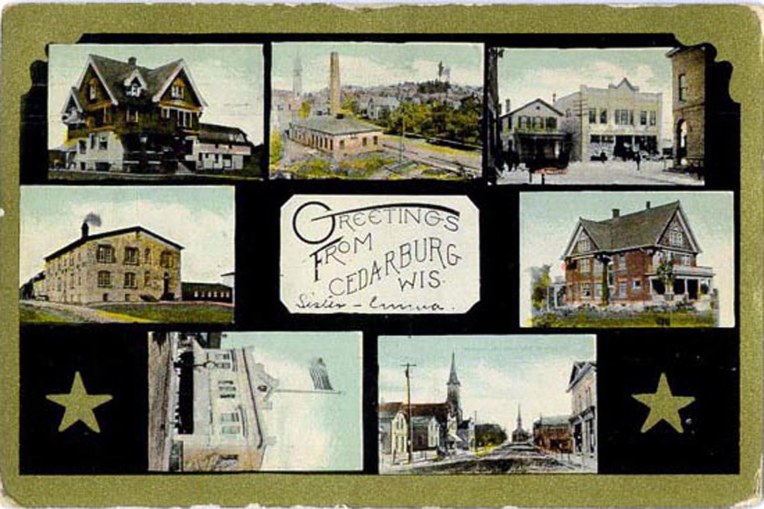
The advances that had been made across the upper Midwest and West of the United States over the latter half of the 19th century resulted in profound changes for the small German-American farming community of Cedarburg as well.
One of our subjects, Johann Nieman (1842 – 1922), emigrated as a 10-year-old boy in 1852. (see post: Pioneering) He traveled north of Milwaukee with his siblings, parents and grandfather by ox-cart. The road, such as it was, was a dirt track, although for heavily trafficked routes it might be a plank road which was a luxury:

Source: rootsweb.ancestry.com
In 1907, the Interurban electric railway (passengers only) reached Cedarburg and in 1908, it reached Sheboygan, a 57 mile route. It operated hourly. For 30 cents, 65 year old Johann could ride rapidly from Cedarburg to Milwaukee in comfort.
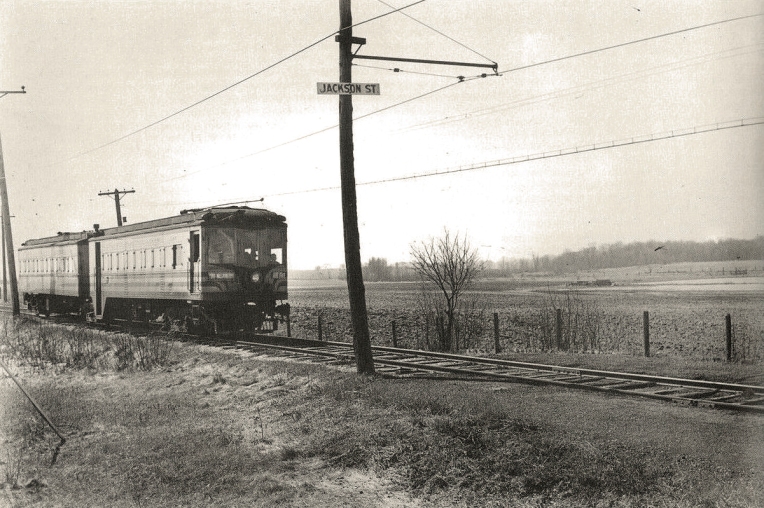
Source: Harold Dobberpuhl
The contrast is so incredible that only one who experienced it, such as Johann, could truly appreciate the magnitude of change. This example is just one of the many facets of change so profound that it is hard to mentally connect the terrain and society of 1900 with that of the emigrants in the wilderness of 1850. Hard work, frugality, cooperation, intelligence, character and advances in engineering and manufacturing had created a prosperous world utterly alien in material terms to that of the 1850s.
While the Interurban was an extraordinary advance for access to other communities along the line, the horse remained the primary mode of transportation. Social interaction was limited by the range of a trip by horse from home – not far. Romance, parties, festivities were affairs of a neighborhood, and nearby extended family. In the absence of wide and rapid travel, the consequence was a relatively static culture.
Cedarburg at the turn of the Century
With all of that change, what was a German American farming community in the 1890s/1900 like?
This post provides a brief sketch of Cedarburg, a largely Germanic town, in a county that was almost wholly German as well. It would be a stretch to say that the Cedarburg of that time was typical of German American communities, but it certainly had many elements that were common to that ethnic group.

Source – Germans in Wisconsin, Wisconsin Historical Society
The above map shows Ozaukee County as having greater than 60% of its population with German ethnicity. Cedarburg was likely well in excess of that.

Source LOC, 1915 township plat
Cedarburg was a community of 1,626 population (1900 census) serving the needs of the surrounding farmers and through some of the manufacturing, e.g., wire, nails, woolen goods, beer, etc., serving more distant customers as well.
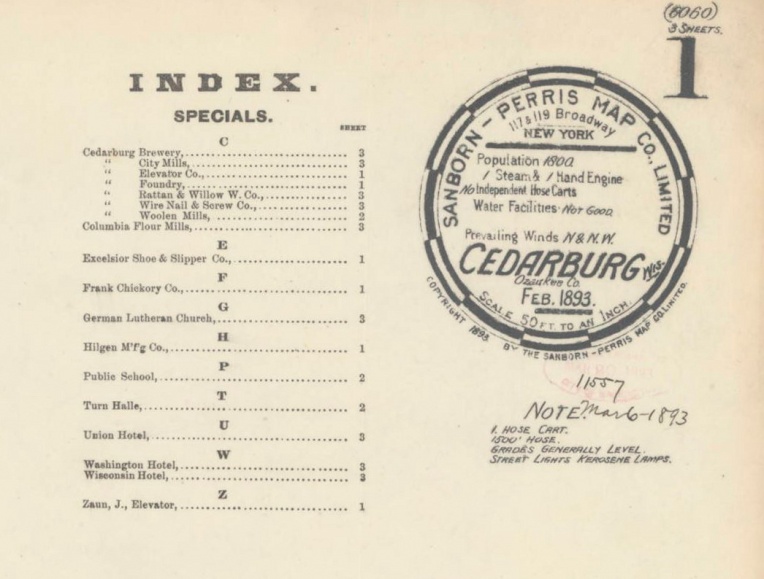
Source Wisconsin Historical Society – Sanborn maps
The above is a header from an insurance map from 1893. These were published for commercial insurance companies (maps not sold to the public) for many communities across the US. It notes the 1893 population at 1800, which conflicts with the 1890 census of 1361 and the 1900 census of 1626 per Wikipedia. The census is likely accurate. The map lists the various commercial and manufacturing concerns in Cedarburg. There was an amazing amount of enterprise in the community. We would be hard put today to find a town of comparable size with such extensive industry and commerce:
- Brewery
- City Mills
- Elevator Co
- Foundry
- Rattan & willow W. Co
- Wire Nail & Screw Co
- Woolen Mills
- Flour mills
- Excelsior Shoe & Slipper Co.
- Frank Chickory Co
- Hilgen Mfg. Co
- Elevator (J. Zaun)
And three hotels.
It is of particular interest to note in the header of the inspectors assessment respecting fire prevention in the Cedarburg community:
- Steam & Hand Engine
- No independent hose carts
- Water Facilities Not Good!!!
“1 hose cart, 1,500′ hose, grades generally level, street lights kerosene lamps”
The map for Cedarburg consists of three sheets, (see: Sanborn 1893 map Cedarburg) and it sheds a little light on the era to note the concerns of the insurance authorities of that time, e.g, the Woolen Mills:
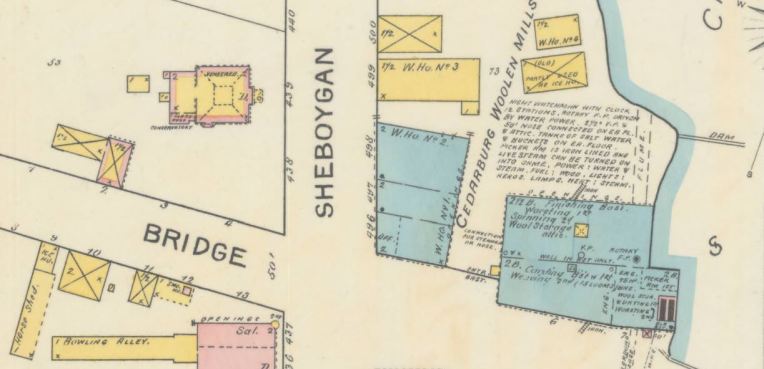
Source: Wisconsin Historical Society – Sanborn maps (Note – Sheboygan St. is renamed Washington on modern maps. There was no Washington Ave. in 1893 when the map was drafted)
The notation above the woolen mill reads:
“NIGHTWATCHMAN WITH CLOCK 12 STATIONS. ROTARY F. P. (FIRE PUMP) DRIVEN BY WATERPOWER. 2 ½ INCH F.P.-?- (PIPE?) & 50 FOOT HOSE CONNECTED ON EACH FLOOR & ATTIC. TANKS OF SALT WATER & BUCKETS ON EACH FLOOR. PICKER ROOM IS IRON LINED AND LIVE STEAM CAN BE TURNED ON INTO SAME. POWER: WATER & STEAM. FUEL: WOOD. LIGHTS: KEROSENE LAMPS. HEAT: STEAM”
The rapidity of change in Cedarburg is illustrated in the two photos below, taken about 40 years apart – about 1860 to 1900:
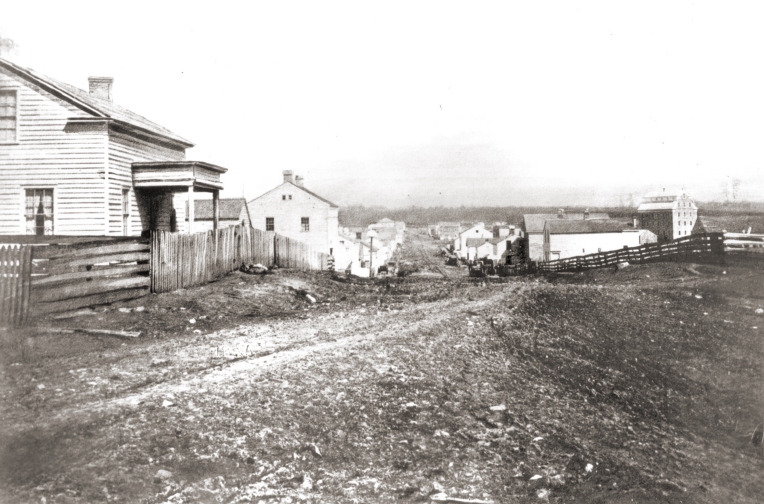
Looking north on Washington Ave. (earlier named Sheboygan & note – dates on this image have been seen as 1856 and also 1865)
Source: Edw Rappold
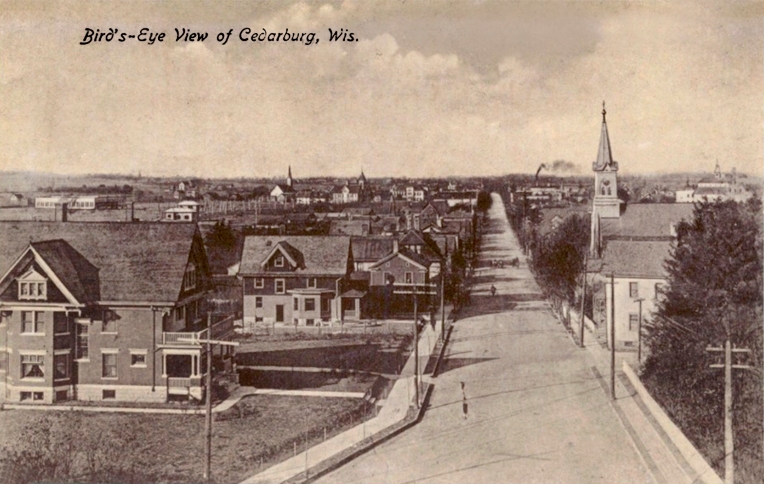
Source: Edw Rappold
The scene immediately above has changed far less with the passage of more than a century from 1900 until now, 2016, than it did with the passage the preceding 40 years.
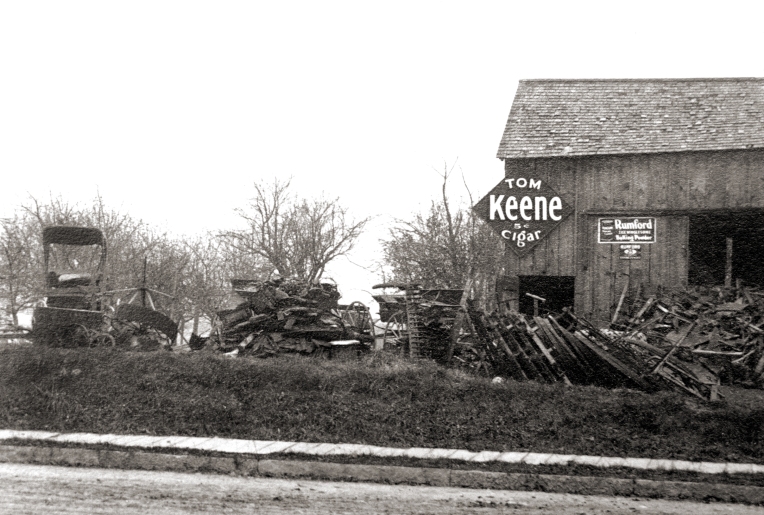
Source: Edw Rappold
What began as agricultural land was soon absorbed by the expanding town. The large house on the far left in the previous photo at the top of Washington Ave:

replaced the barn and junkyard for agricultural implements – about 1900.

The windmill from the pioneering era continued in use until it was destroyed by fire in 1894 (Lisa Curtis “Cedarburg”).
 Source Russ Waters,
Source Russ Waters,
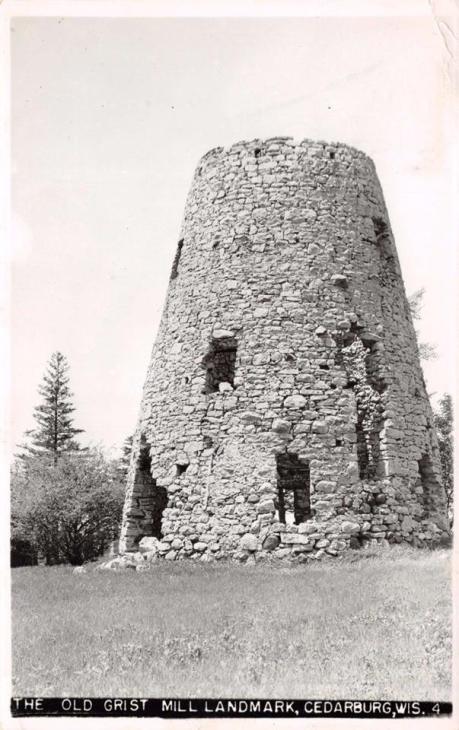
Source – Bob Wundrock Collection
Remnants of the windmill surrounded by a mature community. The decayed structure was finally torn down in 1947.
 Source: Edw Rappold
Source: Edw Rappold
The water powered grist mill was built in 1855 and the wind mill and the water powered mill operated during the same period. The wind mill, dependent on wind currents was unreliable. The water powered mill continued in use (eventually converted to electrical power) well past the middle of the 20th Century.
 Source: Edw Rappold
Source: Edw Rappold
The church was at the center of social, spiritual, and musical life as well as nurturing brotherhood and sisterhood among the parishioners. The structures above sequentially served Immanuel Lutheran Church. The pastor for 46 years was Rev. Ernst Strassburger.
 Source: Edw Rappold
Source: Edw Rappold
Cedarburg Traffic Jam – Cattle Fair Day – village streets of that era were a mess.
Horse and wagon we expect to see. Storefronts remain familiar. But mud? The village streets were usually unpaved mud, ruts, dirt and dust. The sidewalks were boardwalks at best. Horses were present on the streets in large numbers, and were stabled next to and behind storefronts and houses throughout downtown Cedarburg. What went into the front end of a horse came out the back end dramatically changed. A single horse left behind 20-25 lbs. per day of solid evidence of its existence, together with copious quantities of urine. All of those hundreds of horses on Market Day in Cedarburg ensured that the streets were well fertilized.
Trucks did not exist and consequently livestock headed to the Cedarburg butcher were either led or driven. A small herd of pigs would occasionally be observed moving down the main street, Washington Avenue. Such streets could not be readily cleaned and their smell would have been reminiscent of a barnyard.
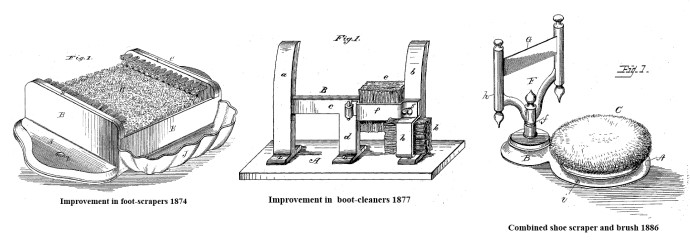
Boot scrapers were a common sight embedded in the concrete by steps leading into commercial and residential buildings including farmhouses.
Understandably, sidewalk cafes were not a prominent feature in Midwestern small towns.
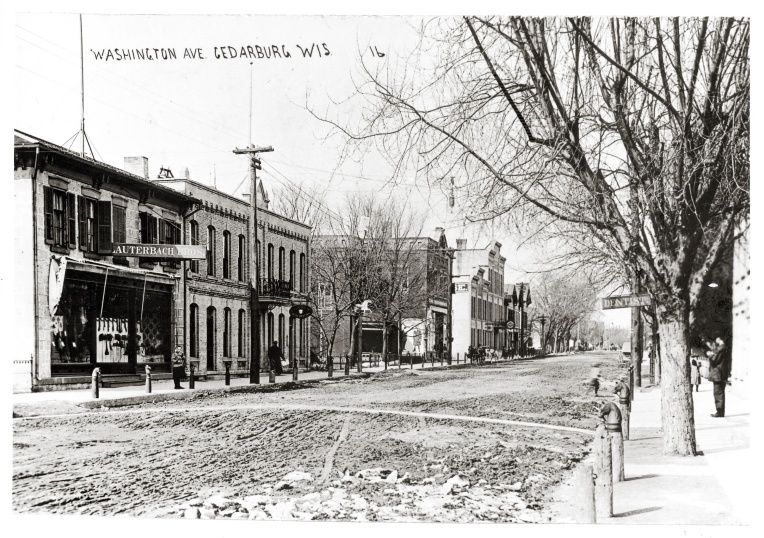 Source: Edw Rappold
Source: Edw Rappold
Downtown Cedarburg, about 1910 – note all of the hitching posts for horses.
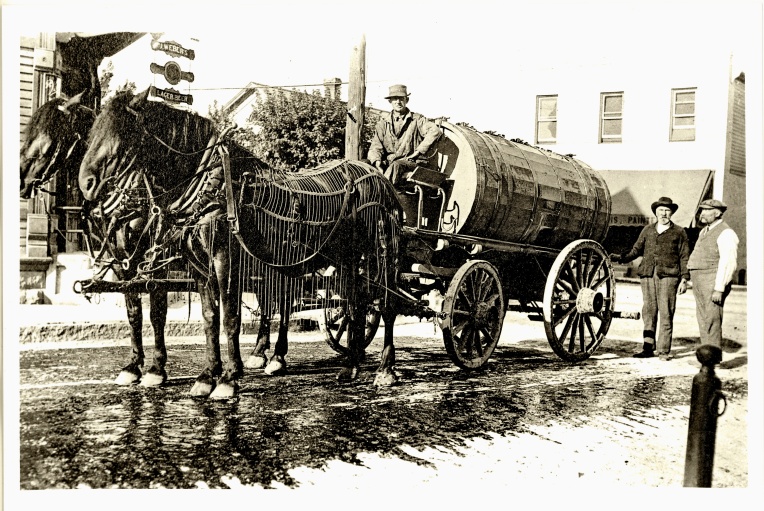 Source: Edw Rappold
Source: Edw Rappold
One wonders how much the sprinkler wagon helped.
Germanic Culture in the Community
The Germanic culture of Cedarburg and the values embodied in it changed only slowly over the last half of the 19th century. This was largely due to the limits on travel and communication for most people given that travel was constrained by the speed of a walking horse and communication by the U.S. Postal Service. Railroads, the Interurban and telegrams were used only in special circumstances.
What had changed was the expectation of material success and independence as a result of hard work, frugality and acceptance of risk. One could succeed in the “New Country.” The hardships of pioneering had paid off.
Culture was enhanced by German language daily newspapers and weekly magazines. For music the community had a brass band and band shell. Churches had pipe organs which played great masterpieces of traditional hymns albeit usually played with modest skill. The church choir provided an outlet for those who love to sing. Services were held in German in the local churches which had very Germanic architecture and decor. Education was highly valued and high school instruction commenced at the turn-of-the-century. For the most part, farm children received formal education only through the first eight grades.
Society wasn’t remotely as fluid as it is now and as a consequence culture was comparatively static.
NEXT – TWO FAMILIES, NIEMAN AND LUEDER, AND DAILY LIFE IN RURAL CEDARBURG IN A TIME OF PROSPERITY AND OPPORTUNITY
Johann Nieman & Sophie Fromm (Sophie is on the far right)
Joachim Lueder & Albertina Brüss





Harry, I am finally getting to reading your ‘manuscript’. The Early Years: Part I was very interesting since the early methods of agriculture have been especially interesting to me. Good job! As usual, you photographic contributions are excellent.
LikeLike
thanks!
LikeLike
He would have loved our cell phones with their weather radar. Sent from my U.S. Cellular® Smartphone
LikeLiked by 1 person
Amazing. I often marvel at the changes Uncle Edgar saw in his lifetime and how well he accepted and adjusted to them. One example is going from Wright brothers to a man on the moon.
Sent from my U.S. Cellular® Smartphone
LikeLiked by 1 person